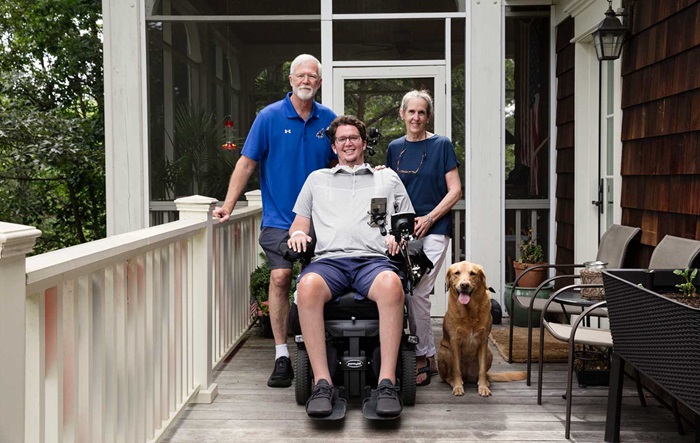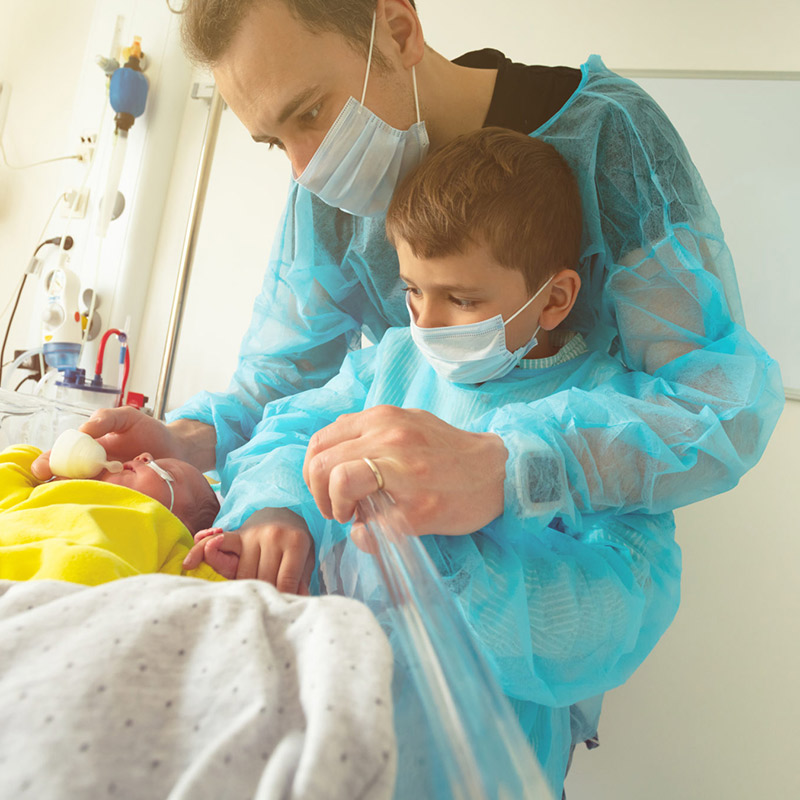Breathing Again After Spinal Cord Injury

August 19, 2021
William Marshall cherishes each hard-fought hour off his mechanical ventilator. The 33-year-old now sleeps more easily through the night without its constant whirring and can sit upright in his wheelchair with the ventilator turned off for part of the day.
Every day he moves closer to being free of the artificial breathing device that pushes air through his windpipe.
“It’s very difficult to come to terms with a spinal cord injury. I can’t move my arms. I can’t move my legs,” William says. “And not being able to breathe on my own is the third and final life-changer. But it’s something I’m striving to recover. Each step forward is a milestone.”
William was a Top Gun F/A-18 pilot driving to the Lemoore Navy Base in California when the driver of a stolen pickup truck, fleeing police, careened through a stop sign. The three-car collision killed two people and left William paralyzed from the neck down, unable to breathe on his own.
William learned about the pioneering work of the Center for Treatment of Paralysis and Reconstructive Nerve Surgery at Jersey Shore University Medical Center. Groundbreaking surgery by Matthew Kaufman, M.D., FACS, is repairing and replacing damaged phrenic nerves, allowing people with paralysis—as well as others with damaged phrenic nerves—to breathe again. Patients have come for the surgery from around the U.S., and from countries such as Japan, South Africa, Bolivia, Israel and Australia.
William says when he learned of the surgery, he thought, “It will be hard work, but maybe I can regain function that I thought was out of reach.”
Groundbreaking Surgery
The phrenic nerves originate in the neck and reach down between the lung and heart to pass motor information from the brain to the diaphragm. There are two phrenic nerves, one on each side of the body. As a plastic and reconstructive surgeon, and a head and neck surgeon, Dr. Kaufman understood how to reconstruct facial nerves and treat peripheral nerve injuries. About a decade ago, he began applying those skills in innovative ways to phrenic nerve injuries and diaphragmatic paralysis.
The complex surgery works to repair the phrenic nerve as well as bypass the phrenic nerve with a nerve transplanted from the patient’s leg. The surgeon may also insert a pacemaker into the patient’s diaphragm if the muscle, essential for breathing, fails to function. For paralyzed patients, the pacemaker will work when the phrenic nerve can start sending signals from the brain again.
“The first problem is that the brain can’t transmit the signal because of the spinal cord injury. In many cases, we also have to overcome a second problem in the phrenic nerves themselves. It’s like having a bad generator and bad wiring. You have to fix both things,” Dr. Kaufman says.
Enabling people with quadriplegia to breathe on their own greatly improves their quality of life, increases their independence, reduces respiratory infections and increases life expectancy. The National Spinal Cord Injury Database reports that about 17,730 people in the U.S. experience a spinal cord injury each year. Some estimates suggest about 6 percent to 8 percent of those who are paralyzed each year become ventilator-dependent.
The surgery is most successful within a year or two of the injury. A handful of other centers have performed phrenic nerve surgery, but none has more experience. Dr. Kaufman and the team have performed close to 500 phrenic nerve surgeries.
Patients with phrenic nerve injuries also benefit from the far-reaching resources of Hackensack Meridian Health, including the expertise of David P. Brown, D.O., one of the few physicians in the world with extensive experience in the nerve conduction studies needed to diagnose patients with damaged phrenic nerves. Dr. Brown is director of the electrodiagnostic laboratory at JFK Johnson Rehabilitation Institute and oversees a team of rehabilitation specialists who help patients retrain the diaphragm after the surgery.
“The EMG evaluation of the phrenic nerve, along with the specialized ultrasound, is critically important for Dr. Kaufman to determine how to surgically manage these patients,” Dr. Brown says. “And our physical therapists have the expertise to evaluate patients and conduct diaphragmatic training, a skill not available in many places.”
Pushing Further Every Day
The phrenic nerve surgery replaces the conduit in which the nerve fibers can grow, though at just 1 mm a day. Patients may not experience improvement for a year, and continued specialized physical therapy is needed to strengthen the diaphragm.
William’s surgery for both phrenic nerves was completed in 2017. Slowly the nerve graft grew and he was able to get a response from the pacemaker placed in his diaphragm. “The diaphragm went gangbusters,” he recalls. “I restored connectivity on both phrenic nerves. Now I am working to rehabilitate the diaphragm muscle fully and I am making gains.” He still uses the ventilator for parts of the day to rest his diaphragm.
“Every month I push it further,” William says. “Already I can sleep in peace. It’s made such a difference in my well-being and mental and physical health. For someone with quadriplegia, that’s crucial. And with an injury like mine, you appreciate every win you can get.”
For Dr. Kaufman, getting the word out is critical. He wants to reach providers caring for people with paralysis as well as primary care providers and pulmonologists. His patients also include people who are not paralyzed but have phrenic nerve injuries following surgery, illness or accidents.
“One of our biggest challenges is letting people with phrenic nerve injuries know that we can help them,” Dr. Kaufman says.
William’s mother, Tricia Marshall, a retired U.S. Navy nurse who now cares for her son, says she’s happy to share her family’s story and let others know about the value of phrenic nerve surgery. She says her son is far more comfortable when he is off the ventilator.
“[William] works incredibly hard to make progress. We hope he will eventually be off the ventilator 24/7. That’s the goal,” she says. “You could call him a pioneer.”
The material provided through HealthU is intended to be used as general information only and should not replace the advice of your physician. Always consult your physician for individual care.







